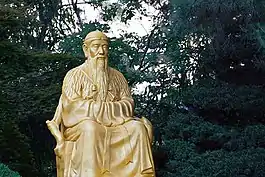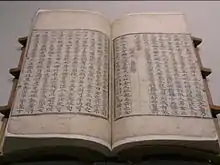Samguk yusa
Samguk yusa (Korean pronunciation: [sʰam.ɡuk̚.ju.sa]) or Memorabilia of the Three Kingdoms is a collection of legends, folktales and historical accounts relating to the Three Kingdoms of Korea (Goguryeo, Baekje and Silla), as well as to other periods and states before, during and after the Three Kingdoms period. Samguk Yusa is a historical book written by Il-yeon who was a Buddhist monk in the late Goryeo Dynasty. It is the earliest extant record of the Dangun legend, which records the founding of Gojoseon as the first Korean nation. The Samguk yusa is National Treasure No. 306.[1]

| Samguk yusa | |
 | |
| Korean name | |
|---|---|
| Hangul | |
| Hanja | |
| Revised Romanization | Samguk yusa |
| McCune–Reischauer | Samguk yusa |
Authorship and dating
The text was written in Classical Chinese, which was used by literate Koreans at the time of its composition. The earliest version of the text is believed to have been compiled in the 1280s, and the earliest extant publication of the text is from 1512 CE.[2]
20th-century Korean scholars such as Choe Nam-seon established the Buddhist monk Iryeon (1206–1289) as the main compiler of the text, on the basis that his name (and full official title) was indicated in the fifth fascicle. This view is widely accepted among modern scholars.[3] The compilation is believed to have been expanded by Iryeon's disciple Muguk (1250-1322) and several others prior to the definitive 1512 recension.[4]
Ha Chongnyong and Yi Kunjik produced a critical edition of Samguk yusa in 1997. According to Ha Chongnyong, Iryeon wrote only the fifth fascicle, since his name is mentioned only in that section of the text.[4]
The 1512 edition of the text mentions a dynastic chronology at the beginning, which has several discrepancies with the information that appears later in the text. According to Robert Buswell, Jr. and Donald S. Lopez, Jr., this chronology may have been a fourteenth-century addition to Iryeon's compilation.[5]
Historical reliability
Many of the founding legends of the various kingdoms in Korean history are recorded in Samguk yusa. The text covers legends from many Korean kingdoms, including Gojoseon, Wiman Joseon, Buyeo, Goguryeo, Baekje, Silla, and Gaya. Unlike the more factually-oriented Samguk sagi, the Samguk yusa focuses on various folktales, legends and biographies from early Korean history. Given its mythical narratives, Samguk yusa's reliability is questionable.[4]
Samguk yusa was not able to precisely interpret and explain the detailed picture of Silla itself as this book was written in the Koryo period, during which a lot of time had passed from the Three Kingdoms of Korea. Although Il-yeon sometimes omitted unnecessary phrases or paraphrased several expressions with the intention of becoming integrated into the whole story, nevertheless, his work was generally an unbiased book, providing the best picture of Silla.[6]
Editions
- Ilyeon (2006) Overlooked Historical Records of the Three Korean Kingdoms, translated by Kim Dal-Yong. Jimoondang: Seoul, Korea. ISBN 89-88095-94-4
- Ilyon (1972; 2006) Samguk Yusa: Legends and History of the Three Kingdoms of Ancient Korea, translated by Tae-Hung Ha and Grafton K. Mintz. Yonsei University Press: Seoul, Korea. ISBN 1-59654-348-5
- 일연 (1996) 삼국유사. Somun munhwasa: Seoul. ISBN 89-7004-002-1.
- 일연 (2002) 삼국유사. translated by Kim Won-jung. Eulyu munhwasa: Seoul. ISBN 89-324-6083-3.
See also
References
- "삼국유사". terms.naver.com (in Korean). Retrieved 2021-06-05.
- Daniel R. Woolf; Sarah Foot; Chase F. Robinson (25 October 2012). The Oxford History of Historical Writing: Volume 2: 400-1400. Oxford University Press. pp. 136–. ISBN 978-0-19-923642-8.
- Sarah Foot; Chase F. Robinson (25 October 2012). The Oxford History of Historical Writing: Volume 2: 400-1400. OUP Oxford. pp. 125–126. ISBN 978-0-19-163693-6.
- John Duncan; Gi-Wook Shin (28 December 2006). The Journal of Korean Studies Vol 11, Number 1 (Fall 2006). Rowman & Littlefield Publishers. pp. 165–185. ISBN 978-1-4422-3484-0.
- Robert E. Buswell, Jr.; Donald S. Lopez, Jr. (24 November 2013). The Princeton Dictionary of Buddhism. Princeton University Press. p. 754. ISBN 978-1-4008-4805-8.
- McBride, Richard D (2006-10-01). "Is the Samgukyusa Reliable? Case Studies from Chinese and Korean Sources". The Journal of Korean Studies. 11: 163–189 – via Jstor.
External links
- The official website showing the original text as well as the translation in Korean Hangul (National Institute of Korean History)(in Korean)
- [Samguk Yusa] (in Chinese) – via Wikisource. Original Text of the Samguk yusa.
- Samguk Yusa - World History Encyclopedia
- 三國遺事 (Links to full text of Samguk yusa in literary Chinese)